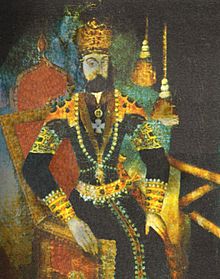Hotaki dynasty
| Hotaki dynasty | |||||
|
|
|||||
| Official language | Persian | ||||
| Capital | Kandahar , Isfahan | ||||
| Form of government | monarchy | ||||
| founding | April 21, 1709 | ||||
| resolution | March 24, 1738 | ||||
The Hotaki dynasty ( Pashtun د هوتکيانو ټولواکمني) was an Afghan monarchy of the Ghilzai Pashtuns, which was founded in April 1709 by Mir Wais Hotak as a result of a successful revolution of the Pashtuns against the Shiite Safavid rulers in the region. At times the territorial expansion of the Hotakis amounted to an area which corresponds to today's Afghanistan, Iran , West Pakistan and some parts of Tajikistan and Turkmenistan .
history

The Persian empire of the Safavids , which had existed since around 1500, included around 1700 not only the area of today's Iran but also large parts of today's state of Afghanistan and the Caucasus . At that time, however, the empire was in a phase of weakness. This contributed to the fact that the Sunnis in the empire were to be converted to the state religion, Shiite Islam. The Pashtuns in the east of the empire were predominantly Sunni, with their (hostile) largest tribes, the Ghilzai and the Abdali . The Hotakis originated in the east of Persia in 1709, in Kandahar , as a result of a successful revolution led by Mir Wais Hotak against the Georgian governor of the Safavids, Gorgin Khan, who is known for his oppression against Sunnis .
Mir Wais Hotaki died of natural causes in 1715 and was succeeded by his brother Abdul Aziz Hotak. However, only two years later, he was overthrown by Mir Wais Khan's son, Mir Mahmud Hotaki . After Mir Mahmud Hotaki's coronation, the Hotakis succeeded in conquering the capital of Persia, Isfahan , in 1722 against an army twice as large. The Safavid dynasty was essentially over.
The rule of the Hotakis in Persia was largely characterized by cruelty and oppression, for example, after 6 months of rule, the people of Isfahan had to feed on rats and dogs.
Even the Armenians in Persia, who were known for their prosperity at that time, did not remain untouched by the rule of the Afghans, so after an unfulfilled request for an unpayable sum of taxes, demanded by the Afghans on the Armenians of Julfa , the entire Armenian settlement was sacked . Mir Mahmud Hotaki also demanded more than 60 Armenian virgins for his harems , this request was granted because the Armenians had no other choice, but it happened that an Afghan general who was ashamed of the demand Mir Mahmud Hotaki and was in front of them disgusted, returned all Armenian virgins untouched to their families, nonetheless at least 12 Armenian women ended up in the Afghan harems.
The Hotaki dynasty found itself in trouble when an internal conflict made it difficult to establish permanent control. The dynasty lived in great turmoil because of the bloody deeds of Mir Wais Hotak's successors, such as Mir Mahmud Hotaki, already mentioned, who weakened their power. After a massacre of thousands of civilians, including more than 3,000 religious educated, aristocrats and members of the Safavid family, the Hotaki dynasty was ousted. In October 1729 she was defeated by Nadir Shah , the leader of the Afsharians, in the battle of Damghan and driven back to the east. Nadir Shah invaded Kandahar in 1738 and eliminated the Hotaki dynasty. The Hotaki dynasty was followed by the Afsharid dynasty .
Ruler
See also
Web links
- Wahid Momand: Mirwais Khan Hotak. (No longer available online.) In: Afghanland.com. 2000, archived from the original on November 6, 2016 .
- George Bruce Malleson: History of Afghanistan, from the Earliest Period to the Outbreak of the War of 1878. WH Allen & Co., London, 1879. Limited preview: Google Books
Individual evidence
- ↑ George Bruce Malleson: History of Afghanistan, from the Earliest Period to the Outbreak of the War of 1878 . Elibron.com, London 1878, ISBN 1-4021-7278-8 , p. 227 (accessed September 27, 2010).
- ^ Martin Ewans: Afghanistan: a short history of its people and politics . Perennial, New York 2002, ISBN 0-06-050508-7 , p. 30 (accessed September 27, 2010).
- ^ Safavid Dynasty. Accessed April 13, 2020 (English).
- ↑ Gorgin Khan. Retrieved April 13, 2020 .
- ↑ Jonathan L. Lee: Afghanistan: A History from 1260 to the Present . S. 78 .
- ^ Afghanistan: A History from 1260 to the Present, page 78
- ↑ Jonathan L. Lee: Afghanistan: A History from 1260 to the Present . S. 78-79 .
- ↑ Jonathan L. Lee: Afghanistan: A History from 1260 to the Present . S. 79 .
- ↑ Jonathan L. Lee: A History from 1260 to the Present . S. 79 .
-
^ D. Balland: Asraf Ghilzai. In: Encyclopaedia Iranica , Online Edition. August 17, 2011, accessed January 19, 2019 . Frank Raymond Allchin, Marvin G. Weinbaum, Nancy Hatch Dupree, Mohammad Ali, Victor P. Petrov, Louis Dupree: Afghanistan: The Hotakis. In: Encyclopaedia Britannica . January 3, 2019, p. 13 , accessed on January 19, 2019 .
- ↑ Ralph H. Magnus, Eden Naby: Afghanistan: Mullah, Marx and Mujahid. P. 29

